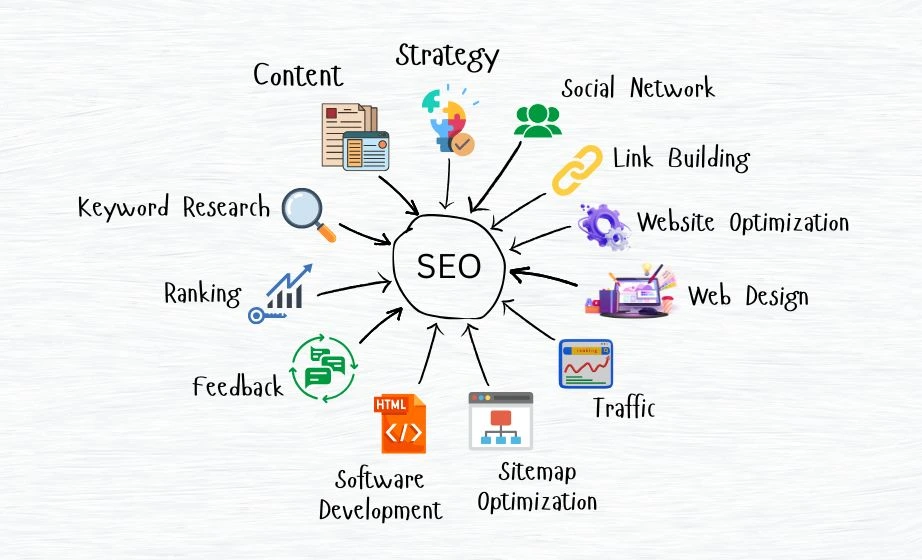What is SEO Marketing and How It Powers Business Growth in 2025 ?
In this Digital Marketing era, SEO Marketing, or Search Engine Optimization Marketing, is a popular, effective way of promoting your business to make websites and products accessible to customers.
Search engine optimization Marketing, or SEO Marketing for short, refers to the process of optimizing your website’s ranking in search engine results to increase its visibility to potential customers, and it plays an important role in digital marketing.
In essence, SEO consists of a set of well-thought-out practices for enhancing different aspects of a website, including content quality, URL structure, keyword research, page loading speed, and linking internally and externally.
By optimizing these elements, search engines can more clearly understand the value of the site and rank it higher in their results pages when people search for information related to the company.
If you want to grow your business, then collaborate with us – the Growfore team of SEO experts. In this blog post, we’ll explore how SEO Marketing (search engine optimization marketing) is used in digital marketing and how it works.
What is SEO Marketing?

SEO Marketing stands for Search Engine Optimization Marketing and represents a method to enhance website visibility, better reach, and higher ranking across the SERP without having to spend any money to advertise.
Accordingly, the purpose of SEO will be to boost the quality and quantity of the flow of web traffic by designing and developing appropriate content that impresses search engines like Google, Bing, or Duck Duck Go.
Besides, YouTube, Facebook, and LinkedIn also have their search, which needs SEO to make the websites appear on top of the list. SEO is the technique used to improve a website’s ranking in search engines using various strategies and keywords to increase the visibility of the website, thereby attracting more visitors and clients.
What is SEO Ranking?
SEO ranking designates the positioning a web page receives within search engine results pages for targeted search queries. The ranking of search algorithms is based on several elements: content quality, keyword usage, user engagement, site load speed, mobile friendliness, and high-quality backlinks.
What’s the Importance of SEO in Digital Marketing?

Having a high Search Engine Optimization Marketing ranking is critical for webpages, as this will help raise the visibility of a website considerably and bring in organic traffic and potential clients in greater numbers.
SEO is key in today’s times because it enhances not just the possibility of being found on a website but also builds some sort of trust and belief in the minds of users.
Additionally, SEO provides an inexpensive way to reach the audience compared to paid advertising, ensures long-term sustainability, and gives them an edge over others in the digital marketplace.
Effective SEO strategies have the potential to bring in a better user experience and engagement, thus driving more conversions and business.
How SEO Works?

Search Engine Optimization Marketing is the process of improving website ranking on search results pages. This process involves the manipulation of a website to naturally appear on top when users submit their queries and keywords.
SEO helps search algorithms and crawlers locate the website online. Key Elements of SEO further discuss in detail how it is achieved.
Types of SEO in Marketing
1. On-Page SEO
On-page SEO, popularly referred to as webpage SEO, incorporates working on the content and web pages to enhance the ranking in a particular search engine for relevant traffic generation.
This entire process is based on several sub-elements, including:
| Element | Description |
|---|---|
| Title Tags | HTML elements that specify the title of a webpage are essential for both SEO and user experience. |
| Meta Descriptions | Summaries of web pages that show up under the title in results provided by the search engine that influence the click-through rates. |
| Headers (H1,H2,H3…H6) | Hierarchical tags help to place the content structurally and make it easier for search engines and users to comprehend. |
| Keyword Optimization | The use of keywords strategically over the content to enhance visibility on the search engine. |
| Content Quality and Relevance | High-quality, informative, and engaging content that meets the needs and expectations of users. |
| URL Structure | Clean and descriptive URLs that reflect the content and are easy for users and search engines to read. |
| Internal Linking | Links within the website that connect related webpages and its content, help in navigation and SEO. |
2. Off-Page SEO
Off-page Search Engine Optimization refers to the optimization activities that occur outside of web pages. Activities under this category will help improve SERP rankings and increase website traffic.
Some sub-elements of Off-page SEO include:
| Element | Description |
|---|---|
| Backlinks | A link in a website that is distinct and is of another website helps to drive traffic to the website and make it more readable for the search engine. |
| Social Signals | User involvement metrics and signals in social media platforms indirectly influence SEO by increasing visibility and driving traffic. |
| Brand Mentions | References of a brand across the web can enhance visibility and reachability even without direct links. |
| Guest Blogging | Writing articles for other websites to build backlinks and increase brand exposure. |
3. Technical SEO
Technical Search Engine Optimization includes all the settings and measures that may be implemented on a website and its server. The work can directly or indirectly impact how search engines crawl, index, and rank a website.
Some of the key actions or sub-elements include:
| Element | Description |
|---|---|
| Website Speed and Performance | The site loading time enhances the user experience and also influences SEO and site ranking. |
| Mobile-Friendliness | Assuring the better responsiveness of the website on mobile devices, which is vital for SEO marketing. |
| XML Sitemaps | Files that list all the pages of a website, helping search engines crawl and index the site more effectively. |
| Robots.txt | A file that tells search engines which pages to crawl and which to exclude, controlling site indexing. |
| Secure Sockets Layer (SSL) | Security technology for establishing an encrypted link is essential for protecting data and improving SEO. |
SEO Techniques
Search Engine Optimization Marketing experts have different methods for optimizing a website, and all these practices have different consequences.
The details of such practices are briefly explained below.
1. White Hat SEO
2. Black Hat SEO
3. Grey Hat SEO
1. White Hat SEO
White Hat SEO is the means of legitimately improving one’s website ranking in the search engines by following guidelines provided by the search engines themselves using ethical techniques.
This would include high-quality content with relevant keywords, a solid strategy, and a focus on long-term results. The goal is to enhance user experience, trustworthiness, and authority.
2. Black Hat SEO
Black Hat SEO refers to the use of unethical methods to trick search engine algorithms and promote websites to the top. This is done in violation of the guidelines of search engines and using methods that are too risky, which may lead to penalties or even de-indexing.
3. Grey Hat SEO
Grey Hat SEO is midway between White Hat and Black Hat SEO; here, both techniques are used in the service of raising a website’s ranking in search engines. This would temporally elevate a website’s position until the time search engines discover some sort of unethical means being used.
It is somewhat like walking on a tightrope: you benefit from the thrill of risk getting into trouble. It means practitioners are required to keenly weigh the benefits the methods offer against the chances of being penalized.
How Search Engines Work?
Every time one wants something on the web, they use a search engine. A search engine is almost used in everything we do online. The most widely used search engine in the world is Google, and this holds the highest rank in the market share.

Search Engines are websites, functions, and tools developed with the assistance of users to help them find relevant information without any complication. They provide mechanisms that systematically facilitate searching to find information. Their functions could be categorized based on three parts: Crawling, Indexing, and Ranking.
Besides these, other factors may contribute to listing and ranking in the search results.
Crawling
This is the first step of a process where programmed bots called spiders or crawlers navigate through web pages by going through links, collecting understandable data about each content on the pages to construct a deep understanding of the internet.
Indexing
Indexing is the second step after crawling where the collected data is organized into a huge database known as index, operating like a catalog of libraries to evaluate and sort pages based on their content and keywords, enabling rapid and precise retrieval of application search results.
Ranking
The final step in the search engine process is called ranking contains uses complex algorithms to analyze aspects such as keyword usage, quality of page, user involvement and backlinks to regulate and put forward the appropriate and excellent output when a user inputs a search query.
Search Algorithms
Search algorithms form the core of any search engine. They are detailed and complex mathematical formulae that grade several factors about the website, like page quality, keywords used, structure of the site, backlinks, and other user-interaction signals. They grade each web page by relevance and quality to provide the best results from a given user query.
Importance of Relevancy and User Intent
The effectiveness of the results that come from a search engine would depend on relevance to the user’s query and intent. Relevance within search results simply means that content is closely related to what a user is trying to find; it understands the text and meaning behind the search terms.
User intent refers to the purpose behind a user’s search query. It could be to search for something, to navigate to a certain website, or to make a purchase. With a focus on user intent, search engines can return quality content that enhances the user experience of their searches.
Types of Search Results
It contains all the various elements that comprise, in essence, three important result types: organic, paid, and everything in between text and image to video to rich snippet results, among others, which can shift in and out depending on whether the platform used is a phone or computer.

Summary
Search Engine Optimization Marketing is a vital part of digital marketing, as SEO has a huge effect on a website’s visibility, traffic, and overall success. With SEO, web pages get higher rankings along the search engine results page (SERPs), driving more relevant and organic traffic by optimizing the different features of a site: quality of content, keyword usage, technical infrastructure, and strategy of backlinks.
While the implementation of search engine optimization marketing strategies may appear to be an uphill task, what is derived from it cannot be gained. It is thus prudent that one begins now by focusing on on-page and off-page SEO techniques, added to technical SEO, for a solid foundation of your online presence locally and globally.
Remember, Search Engine Optimization Marketing is a continuous process; one has to keep learning and adapting to the changes. Staying informed about the latest SEO trends and algorithm changes will help maintain and improve your rankings over time.
Grow Your Business With Us

If your business is looking to grow and achieve tangible results through SEO, partnering with experts can make a significant difference. Growfore Solution offers comprehensive SEO services aimed at improving your website’s performance and driving growth.
Our team will work with you to plan and implement the best SEO strategy within your business objectives. At Growfore Solution, see how our custom-fit SEO services can help take your website to the next level.
Let us guide you through the maze of SEO to attain the much-needed visibility and success of your business. Contact us todayfor a free consultation and to get started on the path to better search rankings and more website traffic.
Frequently asked questions
How does YouTube SEO work?
YouTube SEO is about optimizing videos for higher search rankings on YouTube. Use relevant keywords in titles, descriptions, and subtitles. Organize content into playlists, optimize your channel with keywords, and upload consistently. Monitor performance with YouTube Analytics and make data-driven adjustments for success. Consistent optimization and engagement are crucial for a successful YouTube presence.
How can SEO be used in marketing?
Establishing an impactful SEO strategy can enhance online presence on various platforms, increase reach across the digital landscape, drive lead generation efforts, and successfully convert leads into loyal clients.
Why is SEO important?
Search Engine Optimization (SEO) is an essential aspect of modern Digital Marketing, crucial in enhancing online visibility and credibility. It is a cost-efficient strategy to attract organic traffic and build trust with the target audience. SEO plays a pivotal role in helping search engines crawl websites and rank them in search engine results pages (SERPs), making it a fundamental element of digital marketing strategies.
Why are keywords important for SEO?
Keywords are crucial for guiding users and optimizing search engine functions. SEO practitioners must conduct thorough keyword research to identify the words users enter into search engines. This research is essential for SEO success and greatly influences content strategy and online visibility.
Which tools are used for keyword research in SEO?
There are several tools available for keyword research, with most being paid options. However, some can also be used for free, although with limited information. Some examples of these tools include Google Keyword Planner, Semrush, Ahref, and Answer The Public.
YouTube SEO is about optimizing videos for higher search rankings on YouTube. Use relevant keywords in titles, descriptions, and subtitles. Organize content into playlists, optimize your channel with keywords, and upload consistently. Monitor performance with YouTube Analytics and make data-driven adjustments for success. Consistent optimization and engagement are crucial for a successful YouTube presence.
Establishing an impactful SEO strategy can enhance online presence on various platforms, increase reach across the digital landscape, drive lead generation efforts, and successfully convert leads into loyal clients.
Search Engine Optimization (SEO) is an essential aspect of modern Digital Marketing, crucial in enhancing online visibility and credibility. It is a cost-efficient strategy to attract organic traffic and build trust with the target audience. SEO plays a pivotal role in helping search engines crawl websites and rank them in search engine results pages (SERPs), making it a fundamental element of digital marketing strategies.
Keywords are crucial for guiding users and optimizing search engine functions. SEO practitioners must conduct thorough keyword research to identify the words users enter into search engines. This research is essential for SEO success and greatly influences content strategy and online visibility.
There are several tools available for keyword research, with most being paid options. However, some can also be used for free, although with limited information. Some examples of these tools include Google Keyword Planner, Semrush, Ahref, and Answer The Public.



